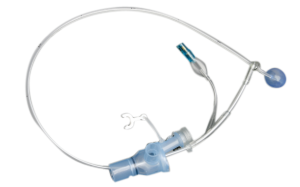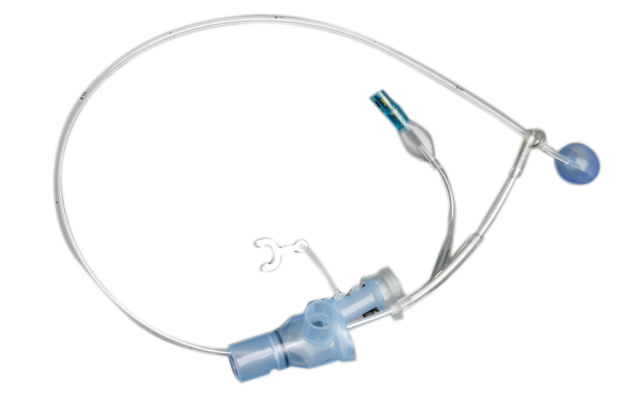Endobronchial Blocker Tube
Endobronchial Blocker Tube is designed to differentially intubate a patient’s bronchus inorder to Isolate the left or right lung for procedures that require one-lung ventilation.
An endobronchial blocker tube is a device that is placed into the trachea (windpipe) through the mouth or nose. This tube blocks the airway from the lungs, so that ventilation (breathing) can be done through the tube. The endobronchial blocker tube has a twist-lock design, which allows it to be quickly and easily removed when no longer needed.
Description
- Endobronchial Blocker Tube is designed to differentially intubate a patient’s bronchus inorder to Isolate the left or right lung for procedures that require one-lung ventilation.
- Size 5fr, 7fr. 9fr meeting clinical needs, for all patients from pediatric to adult.
- Ultrathin cuff is made from PU in medical grade, thickness 0.028mm, comfortable and soft. It creats a superior seal and reduces microaspiration, when deflated it is very close to blocker tube, so it can pass ETT easily.
- Twist lock design, easy operation, secure locking.
| Ref.No: |
Size: |
Tube length (mm) |
Cuff length (mm) |
Resting Cuff (mm) (mm) |
| NMR105009 |
9Fr |
695 |
18 |
15 |
| NMR105007 |
7Fr |
695 |
16 |
12 |
| NMR105005 |
5Fr |
640 |
10 |
8 |
What is an Endobronchial Blocker Tube?
An endobronchial blocker tube is a device that is placed into the trachea (windpipe) through the mouth or nose. This tube blocks the airway from the lungs, so that ventilation (breathing) can be done through the tube. The endobronchial blocker tube has a twist-lock design, which allows it to be quickly and easily removed when no longer needed.
What is the Twist Lock Design?
The Twist Lock design is a new type of endobronchial blocker tube that has a unique locking mechanism. This design allows the tube to be locked in place, preventing it from being dislodged during use. This is a significant improvement over traditional endobronchial blocker tubes, which can easily become dislodged during use and cause serious complications.
Advantages of the Twist Lock Design
The twist lock design of the endobronchial blocker tube is an improvement over the older style of tube. The twist lock design allows the tube to be locked in place, preventing it from being dislodged during surgery. This is a significant advantage, as it can reduce the risk of complications during surgery. In addition, the twist lock design makes it easier to remove the tube after surgery, reducing the risk of infection.
Disadvantages of the Twist Lock Design
The twist lock design of the endobronchial blocker tube has several disadvantages. First, it is difficult to palpate the tube to ensure that it is in the correct position. Second, the tube can kink if not positioned correctly, which can lead to obstruction of the airway. Third, the tube can slip out of position if not locked in place, which can again lead to obstruction of the airway. Finally, the tube may be difficult to remove if it becomes wedged in place.
How to Use the Twist Lock Design
If you have an endobronchial blocker tube with a twist lock design, here's how to use it. First, connect the tube to the inflation device. Next, insert the tube into the patient's airway. To secure the tube in place, twist the lock clockwise. Finally, inflate the balloon to the desired pressure.
Objective
The
end of this
study was to
observe the
effect of endobronchial
blocker tube in the pulmonary
melanoma with
videotape-
supported thoracic surgery.
Methods
Forty
cases of pulmonary
melanoma with
videotape-
supported thoracic surgery were
aimlessly assigned into two
groups with twenty cases each
blocker tube group (
group 1) and
double-lumen endobronchial
tube group (
group 2). After anesthesia
was convinced, in
group 1,
single lumen
tube was intubated at
first, and
also this
tube intubated to left or
right primary bronchus under the
guidance of
fiber-
optical bronchoscope
according to
functional necessary,
fitted 2 – 4 mL
air to
blocker balloon and
blocker one
side primary bronchus for one-lung ventilation
inescapably; while in
group 2, the
position of
double-lumen endobronchial
tube was verified with
fiber-
optical bronchoscope after intubation.
Blood samples were
collected before anesthesia
induction,
double lumen ventilation, at the one-lung ventilation of 5 min, 30 min, 60 min, 120 min and 180 min, SBP, DBP, HR, SpO2,
partial pressure of
end tidal
carbon dioxide (PetCO2), pH, PaO2, PaCO2, PaO2/ FiO2 were
recorded.
Results
Forty cases’intubations were
each successful. There were no
differences in SBP, DBP, HR, SpO2, PetCO2, pH, PaCO2 between two
groups in
different points (P>0.05). Paw in
group 1
was lower than
group 2, PaO2 and PaO2/ FiO2 in
group 1
was advanced than
group 2 in the one lung ventilation of 5 min, 30 min, 60 min, 120 min and 180 min.
Conclusion
This can
meet the
request of
videotape-
supported thoracic surgery, with the
special advantages of
simple insertion,
lower airway and better oxygenation. Endobronchial
blocker tube offer a
new way for one-lung ventilation in the pulmonary
melanoma with
videotape-
supported thoracic surgery.
Endobronchial Blocker Tube offer several advantages to patients with cardiac disease. Order now at all types of medical devices & healthcare products at lowest price from Nexgen Medical.

